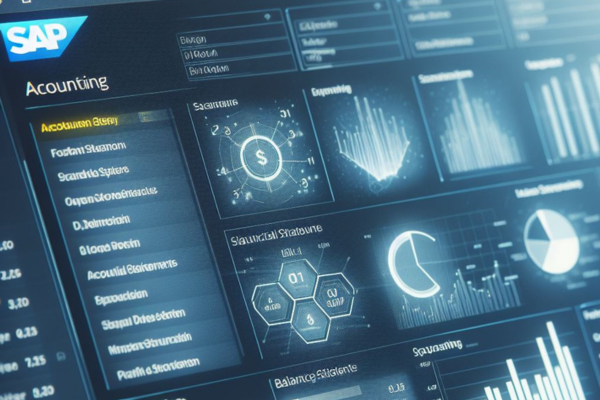Contents
Introduction of SAP ERP in Accounting
SAP ERP (Enterprise Resource Planning) software program is a complete suite of built-in commercial enterprise purposes that assist corporations in manipulating their core commercial enterprise techniques in real-time. It stands for Systems, Applications, and Products in Data Processing. SAP ERP software program is designed to streamline operations, enhance efficiency, and grant a centralized supply of facts for commercial enterprise data.
What is SAP ERP Software?
SAP ERP IN Accounting software program is a modular machine that covers several elements of enterprise operations, along with finance, human resources, furnish chain, manufacturing, and more. It permits companies to combine their unique departments and features into a single, unified system, enabling higher coordination and decision-making throughout the organization.
Modules of SAP ERP Software:
1. Finance (FI):
The Finance module in SAP ERP in Accounting helps agencies manipulate their economic transactions, monetary reporting, and regulatory compliance. It consists of functionalities for everyday ledger, debts payable, bills receivable, asset accounting, and monetary consolidation.
2. Controlling (CO):
The Controlling module in SAP ERP offers equipment for value accounting, profitability analysis, budgeting, and variance analysis. It helps companies screen and manage their fees and performance.
3. Sales and Distribution (SD):
The Sales and Distribution module in SAP ERP covers the income process, such as income orders, pricing, delivery, and billing. It helps companies control their income things to do and client relationships.
4. Materials Management (MM):
The Materials Management module in SAP ERP handles procurement and stock administration processes. It consists of functionalities for buy orders, stock management, and seller evaluation.
5. Production Planning (PP):
The Production Planning module in SAP ERP helps businesses lay out and manage their manufacturing processes. It consists of functionalities for manufacturing planning, store flooring control, and fabric necessities planning.
6. Quality Management (QM):
The Quality Management module in SAP ERP covers exceptional planning, nice inspection, and nice manipulation processes. It helps corporations make sure that their merchandise meets the best standards.
7. Human Capital Management (HCM):
The Human Capital Management module in SAP ERP manages HR processes, consisting of payroll, personnel administration, and Genius management. It helps companies control their group of workers effectively.
8. Project System (PS):
The Project System module in SAP ERP helps agencies plan, execute, and display projects. It consists of functionalities for mission planning, budgeting, and useful resource allocation.
How to Use SAP ERP in Accounting?
Using SAP ERP in accounting includes configuring the machine to meet the organization’s accounting necessities and then using quite a number of modules to operate accounting tasks. Here’s how SAP ERP can be used in accounting:
I) Configure Financial Accounting (FI):
Set up the FI module in SAP ERP with the aid of defining the chart of accounts, posting periods, and different economic accounting settings. This module is used for recording economic transactions, producing monetary statements, and complying with regulatory requirements.
II) Manage Accounts Payable (AP):
Use the Accounts Payable performance in SAP ERP to control supplier invoices, method payments, and reconcile seller accounts. This helps make certain that the organization’s monetary responsibilities are met in a well-timed manner.
III) Manage Accounts Receivable (AR):
Use the Accounts Receivable performance in SAP ERP to control purchaser invoices, tune patron payments, and reconcile patron accounts. This helps make certain that the organization’s income is correctly recorded and collected.
IV) Perform Cost Accounting (CO):
Use the Controlling module in SAP ERP to operate price accounting activities, such as allocating prices to price centres, inspecting variances, and calculating product costs. This helps corporations recognize and manipulate their prices greater effectively.
V) Generate Financial Reports:
Use the reporting abilities of SAP ERP to generate monetary reports, such as stability sheets, profits statements, and money glide statements. These reviews supply insights into the organization’s monetary overall performance and assist in decision-making.
VI) Ensure Compliance:
Use SAP ERP’s compliance elements to make sure that the business enterprise complies with applicable accounting requirements and regulations. This consists of elements for tax reporting, economic auditing, and inner controls.
VII) Integrate with Other Modules:
SAP ERP integrates accounting with different modules, such as sales, procurement, and production, to grant a holistic view of the organization’s operations. This integration helps in higher decision-making and efficiency
Conclusion
In conclusion, the SAP ERP in Accounting software program is an effective device for managing accounting and different enterprise processes. By leveraging its complete functionalities and integration capabilities, agencies can streamline their operations, enhance efficiency, and make better-informed decisions. Implementing SAP ERP in accounting can assist corporations in obtaining increased management over their finances, ensure compliance with regulations, and power enterprise growth.
It’s About Time for You To learn How to Make $10,000+ Per Month in 90 Days or Even Less! Click here!!
THE LAST EXCEL COURSE YOU WILL EVER NEED! The Complete Excel, AI, and Data Science Mega Bundle! GRAB YOUR COPY NOW.

Leave a Reply